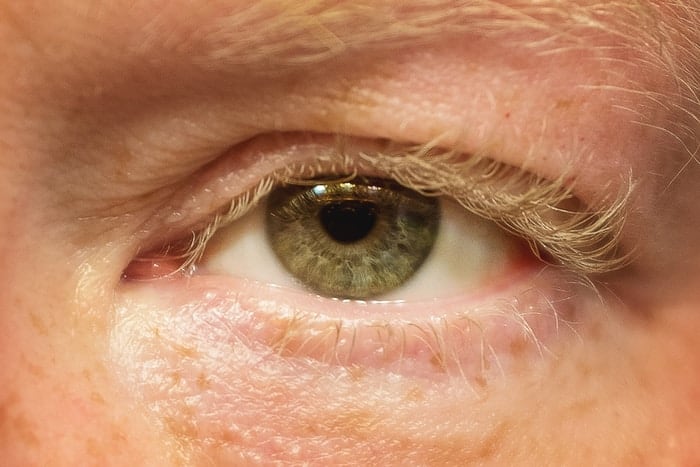Your eyelashes serve more important functions and purposes than what you might realize. Aside from drawing attention to your eyes, your eyelashes also protect your gorgeous peepers from gunk, dirt, dust, debris, and other particles. This is why if something is wrong with your lashes, you will surely know and notice it right away, especially if they curl up on just one of your eyes.

Why are your eyelashes curling up on one eye?
This problem is due to a condition known as eyelash trichomegaly.
Continue reading below to learn the reasons why your lashes curl up on just one eye.
What is Eyelash Trichomegaly?
Eyelash trichomegaly refers to the increase in curling, thickness, pigmentation, or length of your eyelashes. Trichomegaly is a term that was first used in 1944.
There are different causes of eyelash trichomegaly, and these include familial, congenital, drugs, and acquired. Eyelash trichomegaly may become psychologically disturbing and even result in visual disturbances and corneal abrasions once trichiasis occurs.
What Causes Eyelash Trichomegaly?
As mentioned earlier, eyelash trichomegaly is the result of acquired, pharmacological, and congenital disorders.
Eyelashes are the very first terminal hairs that show up during embryological development. The growth cycle of these lashes lasts around 5 to 6 months with an extremely short anagen phase of 30 days and a significantly longer telogen phase at around 4 to 5 months.
Read This Next:
Eyebrows and eyelashes have the least ratio of hair follicles between anagen and telogen, with around 50% of lashes during the anagen phase in comparison to 85% to 90% of hairs on the scalp.
It seems that the epidermal growth factor receptor plays an important role in hair growth, which is evidenced by the drugs that hinder its function. Aside from this, it has also been shown that prostaglandins can convert the telogen phase’s hair follicle to the anagen phase.
There are several immune factors like epidermal growth factor and prostaglandins that seem to be involved in eyelash trichomegaly’s pathophysiology. These two mediators can both increase the anagen period’s duration on the hairs that grow in the area.

It is also believed that acquired eyelash trichomegaly occurs as a result of the topical use of latanoprost, a prostaglandin analog. It has been found that the effects of latanoprost and prostaglandin F2-alpha stimulate not just the follicular melanocytes and murine hair follicles even the conversion to anagen from the telogen phase. The side effect also underwent testing for cosmetic effects.
EFGR or epidermal growth factor receptor inhibitors are also used for the treatment of various solid tumors such as neck and head, lung, ovarian, breast, colorectal, and bladder cancers.
There are two drug classes targeting the epidermal growth factor receptor. The first one is the monoclonal antibodies that can block the receptor itself. The second one is the small molecules that can hinder the tyrosine kinase activity that blocks the receptor activation.
EGFR inhibitor-induced trichomegaly, an effect of the enhanced terminal differentiation, often takes place after 2 to 5 months of treatment. This can also be connected with hypertrichosis in other parts.
Read This Next:
These agents have cutaneous adverse effects that are grouped into the condition called PRIDE syndrome.
There are also different congenital conditions that are linked with eyelash trichomegaly in which only two of them include this as their defining diagnostic feature, namely Cornelia de Lange syndrome and Oliver-McFarlane syndrome.

How is Eyelash Trichomegaly Diagnosed?
The diagnosis of eyelash trichomegaly must include the overall evaluation of the history of the patient as well as other simultaneous medical issues.
The start of eyelash trichomegaly is a critical point to describe a certain etiology. In the event that the condition is present since birth, it is important to look for some other hair anomalies as well as facial features that might be present, like synophrys or alopecia and may indicate any of the congenital syndromes mentioned above.
In the event that the condition has started later on in life, it is important to focus on using topical products or medications. It is also important to take a risk assessment for hepatitis virus or HIV.
What is the Treatment for Eyelash Trichomegaly?
Regular trimming of the lashes is the primary treatment for eyelash trichomegaly if it starts to cause some symptoms. There are also instances when artificial tears and antibiotics might also be necessary for meibomitis or local irritation.
Essential Tips for Eyelash Care
While it might not be easy to determine why your eyelashes curl up on one eye because it is more of a medical condition than a simple cosmetic issue, there are still several tips you can follow to care for your natural lashes properly.
Read This Next:
Say no to over curling.
Obviously, it wouldn’t make sense to over curling your lashes on one eye if they are already too curled. However, you still need to know that squeezing your lashes too hard or curling them too much will only damage your eyelashes more, which can make them weaker and result in falling out. Be sure that you also apply sanitizers on your eyelash curlers to remove any bacteria in them.

Avoid rubbing or scrubbing.
Sleeping with your makeup on or rubbing or scrubbing your eyes constantly is definitely a big no-no because these can harm your eyes and the skin around your eyelashes.
Brush your lashes.
To evenly distribute natural oils along the length of your lashes, brush and comb them two times a day to make them stronger.
Cleanse your face.
You need to carefully clean your eyes with the use of products that will not cause any burning sensation or irritation. Gentle cleansers such as baby shampoos can come in handy for removing your eye makeup and washing your eye area.

Apply oil.
Using oil is great to keep your lashes hydrated and gently remove any eye makeup.
Now that you know the possible reason why your eyelashes curling up on your eye, make sure that you address the issue accordingly and look after your lashes properly to prevent further problems and conditions later on.








